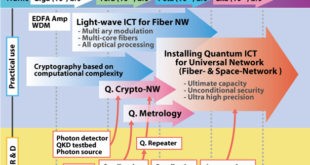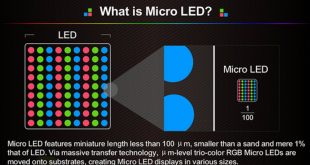Introduction
Quantum technology (QT) has ushered in an era of unprecedented technological advancements, harnessing the peculiar properties of quantum mechanics. Quantum technologies promise to revolutionize computing, communication, and cryptography, offering unprecedented computational power and data security.
Key to this revolution is the utilization of nanomaterials—materials engineered at the nanoscale. In this article, we will explore the fascinating synergy between nanomaterials and quantum technologies and delve into the groundbreaking research paving the way for future quantum innovations.
Quantum Technology Primer
Quantum technology (QT) applies quantum mechanical properties such as quantum entanglement, quantum superposition, and No-cloning theorem to quantum systems such as atoms, ions, electrons, photons, or molecules.
These quantum applications can be classified into three major categories:
- Quantum Computing: Quantum computers have the potential to outperform classical supercomputers by harnessing quantum bits or qubits. Nanomaterials play a crucial role in creating the quantum systems required for these advanced machines.
- Quantum Communication: Quantum communication relies on the principles of quantum entanglement to create secure, unbreakable communication channels. Nanomaterials are instrumental in developing the necessary components for quantum key distribution systems.
- Quantum Sensing: Nanomaterials are highly sensitive to external disturbances, making them ideal for creating ultra-precise sensors. These sensors can measure various quantities, from time and magnetic fields to temperature and more.
Quantum Materials
In the context of the Quantum Age, researchers have turned their attention to a fascinating realm known as quantum materials. Quantum materials can be broadly defined as versatile material platforms that enable the exploration of emergent quantum phenomena and their potential applications in future technology. This umbrella term encompasses a wide range of materials that exhibit specific quantum properties or behaviors.
One significant category within quantum materials includes materials with strong electronic correlations and various forms of electronic order. This can involve materials that exhibit superconductivity or magnetic order. Superconductivity, for example, is a quantum phenomenon where certain materials lose all electrical resistance at extremely low temperatures, leading to unique applications in technology.
Another facet of quantum materials involves materials whose electronic properties are intricately linked to non-generic quantum effects. For instance, topological insulators are materials that exhibit unique electronic properties due to their topological characteristics. Dirac electron systems, such as graphene, are another example where the behavior of electrons is governed by quantum principles, leading to exceptional properties like high electron mobility.
Additionally, quantum materials encompass systems whose collective properties are entirely driven by genuinely quantum behavior. This category includes ultra-cold atoms, cold excitons, and polaritons, among others. These systems exhibit collective behaviors that are a consequence of quantum mechanics, offering exciting prospects for applications in various technological domains.
In essence, quantum materials represent a diverse array of substances that either possess inherent quantum properties, exhibit non-traditional electronic behaviors, or display collective phenomena rooted in quantum principles. Researchers are delving into these materials to unlock their potential for shaping the future of technology in the Quantum Age.
Nanomaterials: An Overview
Nanomaterials are substances with structures and properties that emerge at the nanoscale—typically at dimensions less than 100 nanometers. At this scale, the laws of quantum mechanics come into play, making nanomaterials behave differently than their bulk counterparts. Quantum dots, nanoparticles, and nanowires are some examples of nanomaterials that have garnered significant attention in the realm of quantum technologies.
- Zero-Dimensional (0-D): Examples include quantum dots and fullerenes.
- One-Dimensional (1-D): Carbon nanotubes (CNTs) are a prime example.
- Two-Dimensional (2-D): Graphene, a single layer of carbon atoms, falls into this category.
- Three-Dimensional (3-D): Bulk materials composed of nanostructured grains.
Nanomaterials have found applications in various industries, including cosmetics, healthcare, air purification, and environmental preservation. For instance, some nanomaterials, like carbon nanotubes, titanium oxide, and silver nanoparticles, are already produced on an industrial scale. They are used to enhance cosmetics, deliver drugs with precision in healthcare such as transporting chemotherapy drugs directly to cancerous growths, purify air by removing pollutants, and contribute to environmental conservation efforts. One notable application involves nanoparticles delivering drugs to damaged arteries and cancerous growths to improve treatment outcomes.
Nanomaterials for Quantum Technologies
The marriage of nanomaterials and quantum technologies is propelling innovations in various domains:
- Quantum Information Technologies: Nanomaterials are used to create ion traps, cavity quantum electrodynamics (QEDs), superconducting circuits, and optical systems that facilitate the transfer of quantum information in computing systems.
- Quantum Photonics: Quantum photonics encompasses various devices, including spintronic devices and quantum wires used in waveguides. Nanomaterials play a pivotal role in absorbing specific light frequencies, resulting in excitons—critical components of quantum photonics.
- Quantum Electromechanical Systems (QEMS): QEMS employ nano-fabricated systems operating at the quantum limit. These systems are highly sensitive and find applications in microscopy and detecting magnetic moments of single spins.
Quantum Dots: Quantum dots are tiny semiconductor particles with unique optical properties. Their size-dependent energy levels allow them to emit or absorb light at precise wavelengths. This property is harnessed in quantum dot displays, which produce vibrant and energy-efficient colors. In quantum computing, quantum dots serve as qubits—the quantum equivalent of classical bits—and hold promise for quantum information processing.
Nanoparticles: Metallic nanoparticles, often made of gold or silver, exhibit remarkable properties due to their nanoscale dimensions. They can enhance the sensitivity of sensors, catalyze chemical reactions, and even serve as carriers for drug delivery in targeted therapies. Quantum technologies benefit from nanoparticles in the development of ultra-sensitive detectors and quantum-enhanced imaging systems.
Nanowires: Semiconductor nanowires possess superior electronic properties, making them ideal candidates for quantum devices. These one-dimensional structures enable the creation of quantum bits with long coherence times, a critical factor for quantum computing. Additionally, nanowires have shown promise in the field of quantum communication for transmitting quantum information over long distances.
Carbon Nanomaterials: Pioneering the Quantum Era
One such Quantum material is graphene. This two-dimensional structural form of carbon has unusual physical properties, such as extraordinarily high tensile strength, thermal and electrical conductivity — as well as certain quantum effects. Restricting the already two-dimensional material even further, for instance, by giving it a ribbon-like shape, gives rise to a range of controllable quantum effects.
Empa researchers are leading the charge in quantum technology with their CarboQuant project, funded by the Werner Siemens Foundation. This ambitious endeavor aims to lay the foundations for quantum technologies that operate at room temperature—a significant departure from the conventional need for near-absolute zero temperatures.
Empa’s breakthroughs in synthesizing carbon nanomaterials, particularly graphene nanoribbons, have paved the way for these quantum advancements. This innovative synthesis method allows them to produce carbon nanomaterials with atomic precision, precisely defining their quantum properties. Graphene, a one-atom-thick carbon structure, holds immense potential for faster and more powerful computer architectures.
“Graphene nanoribbons are even more fascinating than graphene itself,” explains Perrin. “By varying their length and width, as well as the shape of their edges, and by adding other atoms to them, you can give them all kinds of electrical, magnetic, and optical properties.”
Graphene nanoribbons hold immense promise, not only for their quantum effects but also for their potential applications in quantum switching, sensing, and energy conversion. The researchers anticipate that the robustness of quantum effects in these nanoribbons could make them observable even at room temperature, paving the way for quantum-based devices that do not require elaborate cooling systems.
Furthermore, the researchers have achieved a groundbreaking quantum effect known as spin fractionalization in their precisely synthesized molecular chains. This effect occurs when multiple spins, fundamental quantum magnets, are brought into a common, coherent quantum superposition, and Empa researchers successfully achieved this in their precisely synthesized molecular chains. These stable quantum effects can be manipulated at room temperature or with moderate cooling, offering the promise of entirely new quantum computers.
Graphene nanoribbons are atomically precise structures that have unique electrical, magnetic, and optical properties that can be tailored by varying their length, width, edge shapes, and atomic composition. However, contacting and studying individual nanoribbons is incredibly challenging due to their tiny dimensions. In a groundbreaking achievement, the team, led by Mickael Perrin and Jian Zhang, has successfully made contact with individual long and atomically precise graphene nanoribbons. To achieve this, they used carbon nanotubes of similar dimensions to ensure precision in their delicate experiment.
Empa researchers have embarked on an ambitious 10-year project called CarboQuant, generously funded with 15 million Swiss francs by the Werner Siemens Foundation. This groundbreaking initiative aims to lay the foundations for novel quantum technologies capable of operating at room temperature, a significant departure from current quantum technologies that often require cooling to near absolute zero.
If successful, CarboQuant could provide Empa researchers with a groundbreaking quantum effect that remains stable and manipulable at room temperature or with moderate cooling. This could potentially revolutionize the development of entirely new types of quantum computers, offering significant advantages over existing technologies.
Challenges and Future Prospects
While nanomaterials hold immense promise for quantum technologies, several challenges must be addressed. Ensuring the stability and control of quantum states at the nanoscale remains a significant hurdle. Additionally, the integration of nanomaterials into scalable and practical quantum devices requires innovative engineering solutions.
Despite these challenges, the synergy between nanomaterials and quantum technologies is propelling us toward a future where quantum computing, communication, and sensing are part of our everyday lives. The development of new nanomaterials and the refinement of existing ones are at the forefront of scientific research, offering exciting prospects for technological breakthroughs.
Conclusion
Nanomaterials are the building blocks of the quantum revolution. As scientists continue to explore their unique properties and harness quantum phenomena, we can anticipate a future where quantum technologies transform industries, empower innovation, and unlock new frontiers of knowledge. Whether it’s the development of quantum computers that can tackle complex problems or quantum communication systems that ensure unbreakable security, nanomaterials are poised to shape the quantum era and redefine what’s possible in the world of technology.
Nanomaterials for Quantum technologies
Quantum information technologies are realized by using nanomaterials for a variety of functions that contribute to the quantum operations within these systems. Nanomaterials can be used to create ion traps, cavity QEDs, superconducting circuits and optical systems to help the passage of quantum information throughout a computing system.
Quantum photonics is a broad area which encompasses everything from spintronic devices to quantum wires used in waveguides. Quantum photonics works when nanomaterials absorb a specific frequency of light, which causes the electrons and holes in the material to recombine through coulombic interactions. This is known as an exciton.
Quantum electromechanical systems (QEMS) are nano-fabricated systems that use a series of transducers operating at the quantum limit. The quantum operation limit creates a highly sensitive system that is usable for both microscopy systems or for detecting the magnetic moment of a single spin.
References and Resources also include:
https://www.nanowerk.com/nanotechnology-news2/newsid=59666.php
 International Defense Security & Technology Your trusted Source for News, Research and Analysis
International Defense Security & Technology Your trusted Source for News, Research and Analysis


